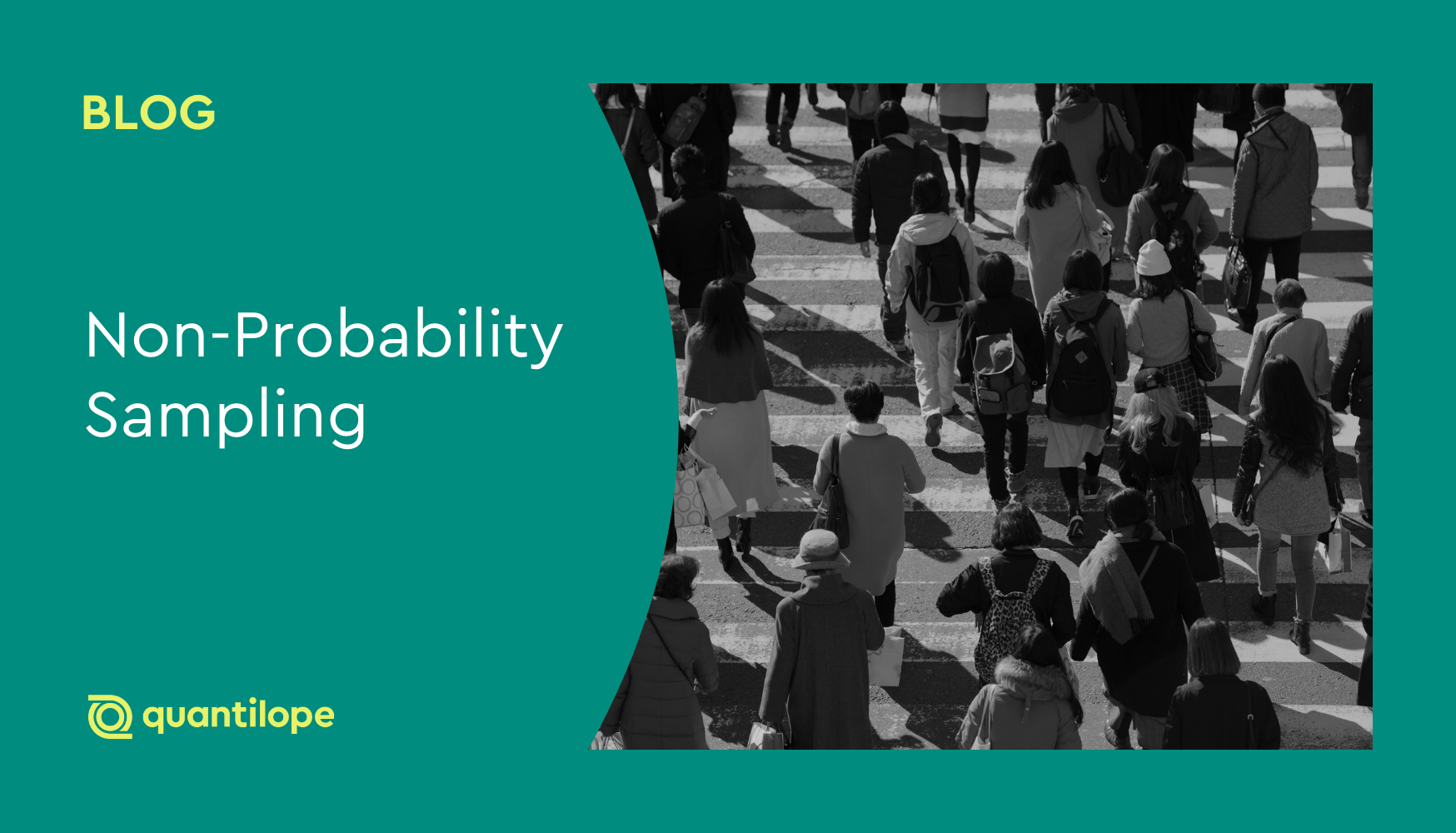In this blog, we’ll dive into what non-probability sampling is, how it differs from other approaches like probability sampling, when to use it, and the benefits/drawbacks to consider.
Gathering consumer data is essential to understand trends, behaviors, and preferences. However, that consumer data needs to accurately reflect the audience/population you’re going after if you’re looking to make business decisions that would be in your customers’ best interest; sampling methods play a crucial role in this.
Sampling methods are the ways insights teams can select/access a subset of individuals from a larger population to represent their current or ideal audience. One sampling approach is non-probability sampling - a technique that offers flexibility and specific advantages.
Table of Contents:
- An introduction to non-probability sampling
- When to use non-probability sampling
- Exploring different types of non-probability sampling
- How technological innovation is shaping non-probability sampling
- Real-world examples
- Advantages and disadvantages of non-probability sampling
- Summary
An introduction to non-probability sampling
Non-probability sampling, as the name implies, does not leave sample selection up to chance (or, to natural probability). Instead, it is a non-random selection methodology in which a researcher selects participants based on certain criteria; this criteria might be the research team’s best judgement of who should participate in their research study or simply who’s available at the time. As such, not every individual in the target population has an equal chance of being chosen when using a non-probability sampling approach.
Non-probability vs. probability sampling methods
-
Non-probability sampling: Relies on more intentional selection criteria - such as quota sampling, in which a research team plans ahead for a certain percentage of respondents to come from a specific demographic or group of people.
-
Probability sampling: Rooted in random selection, ensuring that each member of the population has a known (and often equal) chance of being part of the sample. Because it is probability-based, this type of sampling is ideal for researchers seeking statistical representativeness and generalizable conclusions. Examples of probability sampling techniques include simple random sampling, cluster sampling, and stratified sampling.
When to use non-probability sampling
Knowing there are both probability and non-probability approaches, you might now be wondering how to choose between different sampling techniques and when to use non-probability sampling in particular.
Below are just a few common instances where non-probability sampling often proves to be valuable:
-
Exploratory research: Non-probability sampling is good for early-stage, exploratory research studies to gain preliminary insights or to further refine research questions.
-
Limited resources: Researchers may want to choose non-probability sampling when time or budget constraints make random sampling unrealistic or inefficient.
-
Specific or hard-to-reach populations: Non-probability sampling is good for accessing specific groups rather than the general entire population (such as a car brand looking for feedback from Gen X women who drive an SUV).
-
Qualitative studies: Lastly, non-probability sampling is best when individual perspectives and in-depth understanding through qualitative feedback are more of a priority over statistical generalization.
Exploring different types of non-probability sampling
Now knowing when you might use non-probability sampling methods, let’s now explore some of the different approaches you can take when leveraging this sampling method to collect data.
-
Convenience sampling: Subjects are chosen based on accessibility and availability - aka, who’s conveniently available when it comes time for data collection.
-
Purposive or judgmental sampling: The researcher handpicks individuals based on their knowledge and expertise on the research topic; researchers need to be careful about potential sampling bias when going this route.
-
Quota sampling: A researcher sets quotas to ensure certain subgroups are represented proportionately in the sample (i.e. setting regional, age, and gender quotas so that a certain percentage must come from the North, South, East, or West; from each generational group; and from each gender profile).
-
Snowball sampling: Researchers start by picking a few initial respondents that meet their study’s criteria. They then rely on those respondents to provide referrals for others to take the same survey. This is useful for hidden populations, where existing participants best know who else to recommend for the study (perhaps members of a niche hobby or community).
How technological innovation is shaping non-probability sampling
Finding a qualified sample size for your research objective can be tricky, though innovations in technology are making the process somewhat simpler.
-
Reach and convenience
The internet and digital/online survey platforms allow researchers to quickly access a wide pool of potential survey participants through spaces like online forums and targeted advertisements. This opens up possibilities for reaching specific subgroups and expanding the scope of studies. -
Social media as a sampling pool: Social media is a gold mine for researchers seeking out real consumer voices; these platforms offer near-instant access to seemingly endless volumes of opinions, comments, and user data. Researchers can tap into these pools for sentiment analysis, new and emerging trends, and even direct recruitment of participants for studies focused on specific online communities.
-
Automation and online accessibility: Online market research tools and platforms make it much easier to streamline the sampling process. Researchers can use pre-defined quotas for quick setup or automated libraries of questions in their non-probability sampling approach.
While technology facilitates wider audience reach, researchers need to be careful with self-selection bias which is where only certain types of individuals choose to participate online, skewing results (those with more free time or those particularly passionate about a certain topic). This is less likely to occur with probability sampling, since everyone has an equal chance of participating.
Real-world examples
Below are a few examples of what non-probability sampling might look like in a real-world context.
Clothing brand example
Let’s consider that a small, local clothing brand is developing a new activewear line and wants to hear from their likely brand buyers on when, where, and how often they might wear items from this new line. They decide to reach out to nearby gyms and fitness studios to recruit participants who would be willing to provide their valuable feedback (as individuals that prioritize fitness) via an online survey sent over email. In exchange, the brand offers these respondents 15% off one of their brand items.
The brand gathers feedback from their judgmental/purposive sampling technique around fitness apparel preferences - from fabric types, sleeve length, color options, and more. Because the goal here is to inspire new product development, it’s more about the quality of their feedback rather than statistical analysis, so the non-probability sampling method is a good choice.
Political opinions example
In light of an upcoming election, a political researcher wants to interview individuals in their local county. They want to be sure to get a mix of responses from different demographic, socioeconomic, and political backgrounds. To do so, the researcher leverages online quota sampling.
With this approach, a survey is sent out to a group of willing participants, however they must fall into certain quota groups (Democrat, Republican, make a certain amount per year, etc.). These quotas are based on the general population’s census, providing representative sampling out of a smaller subset of respondents (as surveying the entire population is not feasible). Once a quota group ‘fills up’ (aka, there are enough respondents to represent that group of people based on the total sample size for the survey), no other respondents from that quota group will qualify to complete the survey - they will be ‘screened out’ and their data will not be collected.
As a result, the political researcher is able to gather in-depth insights into their county’s voting perspectives, representative of the wider nation’s population.
Advantages and disadvantages of non-probability sampling
By now you’re an expert on what non-probability sampling is, when to use it, and how it works in real-world examples. However, there are some specific pros and cons to consider when choosing this sampling approach:
Advantages of non-probability sampling
-
Speed and efficiency
Non-random selection of a sample group removes the need to build a detailed sampling frame, thus reducing the time and effort needed to capture responses compared to probability sampling methods. -
Cost-effective
Because researchers can choose respondents using their own judgement or by who is conveniently available, it can be much more cost effective for those with budget constraints. -
Ideal for niche populations
Non-probability sampling is the best approach for harder to reach groups where no complete list of individuals is accessible or where it’s impossible to capture the entire population of interest. It allows voices of these niche markets to be heard, that are often overlooked in random sampling.
Disadvantages of non-probability sampling
-
Increased bias potential
The most obvious downside to non-probability sampling is the increased risk for sampling bias. Because you aren’t randomly recruiting participants based on a formula/non-biased approach, researchers' own biases are more likely to influence the sampling outcome - potentially over or underrepresenting certain viewpoints. -
Less representativeness of the whole population
Since not everyone has an equal chance of being selected (as they do with probability sampling), the sampling group will not mirror the actual target population - making it harder to predict real-world behaviors. This is why this sampling approach is usually better suited for exploratory research. -
Limits generalization of findings
Similar to the above, researchers using a non-probability sampling approach are limited in what findings they can justifiably make. They can’t draw ‘universal’ or ‘general’ conclusions about their findings.
Summary:
Non-probability sampling techniques are good for market researchers to keep in mind in certain surveying scenarios. It’s best used in exploratory research or when budgets are tighter, as it doesn’t typically allow for statistical comparison or data generalizations.
One caveat is that using non-probability sampling with quotas in place does allow for statistical analysis, so long as the questionnaire quotas used are representative of the broader population (e.g. the US census).
To learn more about sampling approaches with quantilope (a panel agnostic platform allowing you to reach any online respondents you wish), get in touch below!


